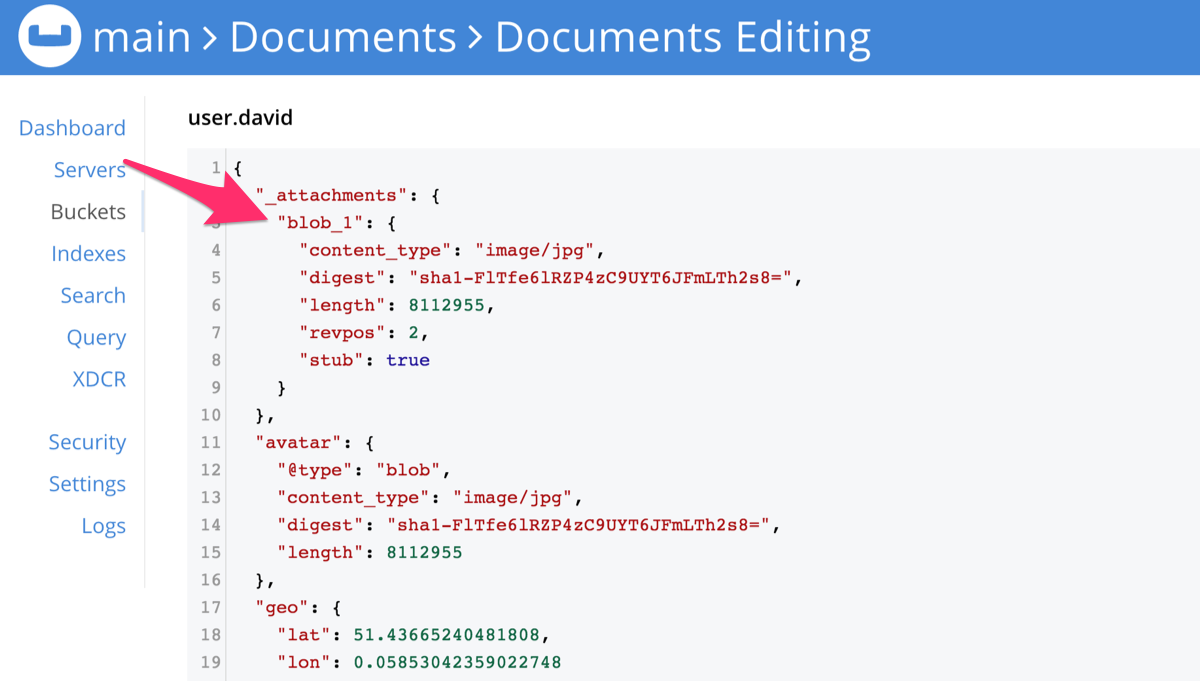Blobs
Couchbase Lite database data model concepts — blobs
Introduction
Couchbase Lite uses blobs to store the contents of images, other media files and similar format files as binary objects.
The blob itself is not stored in the document. It is held in a separate content-addressable store indexed from the document and retrieved only on-demand.
When a document is synchronized, the Couchbase Lite replicator adds an _attachments dictionary to the document’s
properties if it contains a blob — see Figure 1.
Blob Objects
The blob as an object appears in a document as dictionary property — see, for example avatar in Figure 1.
Other properties include length (the length in bytes), and optionally content_type (typically, its MIME type).
The blob’s data (an image, audio or video content) is not stored in the document, but in a separate content-addressable store, indexed by the digest property — see Using Blobs.
Constraints
- Couchbase Lite
Blobs can be arbitrarily large. They are only read on demand, not when you load a document. - Sync Gateway
The maximum content size is 20 MB per blob. If a document’s blob is over 20 MB, the document will be replicated but not the blob.
Using Blobs
The Blob API lets you access the blob’s data content as in-memory data (a ByteArray) or as a Source input stream.
The code in Example 1 shows how you might add a blob to a document and save it to the database. Here we
use avatar as the property key and a jpeg file as the blob data.
Example 1. Working with blobs
// kotlinx-io multiplatform file system APIs are still in development
// However, platform-specific implementations can be created in the meantime
expect fun getAsset(file: String): Source?
val mDoc = MutableDocument()
getAsset("avatar.jpg")?.use { source ->
mDoc.setBlob("avatar", Blob("image/jpeg", source))
collection.save(mDoc)
}
val doc = collection.getDocument(mDoc.id)
val bytes = doc?.getBlob("avatar")?.content
- Prepare a document to use for the example.
- Create the blob using the retrieved image and set
image/jpegas the blob MIME type. - Add the blob to a document, using
avataras the property key. - Saving the document generates a random access key for each blob stored in
digesta SHA-1 encrypted property — see Figure 1. - Use the
avatarkey to retrieve the blob object later. Note, this is the identity of the blob assigned by us; the replication auto-generates a blob for attachments and assigns its own name to it (for example,blob_1) — see Figure 1. Thedigestkey will be the same as generated when we saved the blob document.
Syncing
When a document containing a blob object is synchronized, the Couchbase Lite replicator generates an _attachments
dictionary with an auto-generated name for each blob attachment. This is different to the avatar key and is used
internally to access the blob content.
If you view a sync’ed blob document in Couchbase Server Admin Console, you will see something similar to Figure
1, which shows the document with its generated _attachments dictionary, including the digest.
